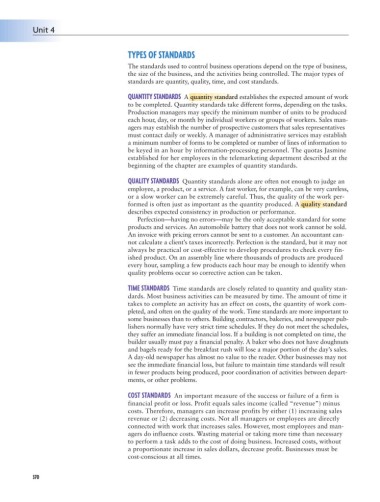Page 383 - Business Principles and Management
P. 383
Unit 4
TYPES OF STANDARDS
The standards used to control business operations depend on the type of business,
the size of the business, and the activities being controlled. The major types of
standards are quantity, quality, time, and cost standards.
QUANTITY STANDARDS A quantity standard establishes the expected amount of work
to be completed. Quantity standards take different forms, depending on the tasks.
Production managers may specify the minimum number of units to be produced
each hour, day, or month by individual workers or groups of workers. Sales man-
agers may establish the number of prospective customers that sales representatives
must contact daily or weekly. A manager of administrative services may establish
a minimum number of forms to be completed or number of lines of information to
be keyed in an hour by information-processing personnel. The quotas Jasmine
established for her employees in the telemarketing department described at the
beginning of the chapter are examples of quantity standards.
QUALITY STANDARDS Quantity standards alone are often not enough to judge an
employee, a product, or a service. A fast worker, for example, can be very careless,
or a slow worker can be extremely careful. Thus, the quality of the work per-
formed is often just as important as the quantity produced. A quality standard
describes expected consistency in production or performance.
Perfection—having no errors—may be the only acceptable standard for some
products and services. An automobile battery that does not work cannot be sold.
An invoice with pricing errors cannot be sent to a customer. An accountant can-
not calculate a client’s taxes incorrectly. Perfection is the standard, but it may not
always be practical or cost-effective to develop procedures to check every fin-
ished product. On an assembly line where thousands of products are produced
every hour, sampling a few products each hour may be enough to identify when
quality problems occur so corrective action can be taken.
TIME STANDARDS Time standards are closely related to quantity and quality stan-
dards. Most business activities can be measured by time. The amount of time it
takes to complete an activity has an effect on costs, the quantity of work com-
pleted, and often on the quality of the work. Time standards are more important to
some businesses than to others. Building contractors, bakeries, and newspaper pub-
lishers normally have very strict time schedules. If they do not meet the schedules,
they suffer an immediate financial loss. If a building is not completed on time, the
builder usually must pay a financial penalty. A baker who does not have doughnuts
and bagels ready for the breakfast rush will lose a major portion of the day’s sales.
A day-old newspaper has almost no value to the reader. Other businesses may not
see the immediate financial loss, but failure to maintain time standards will result
in fewer products being produced, poor coordination of activities between depart-
ments, or other problems.
COST STANDARDS An important measure of the success or failure of a firm is
financial profit or loss. Profit equals sales income (called “revenue”) minus
costs. Therefore, managers can increase profits by either (1) increasing sales
revenue or (2) decreasing costs. Not all managers or employees are directly
connected with work that increases sales. However, most employees and man-
agers do influence costs. Wasting material or taking more time than necessary
to perform a task adds to the cost of doing business. Increased costs, without
a proportionate increase in sales dollars, decrease profit. Businesses must be
cost-conscious at all times.
370

